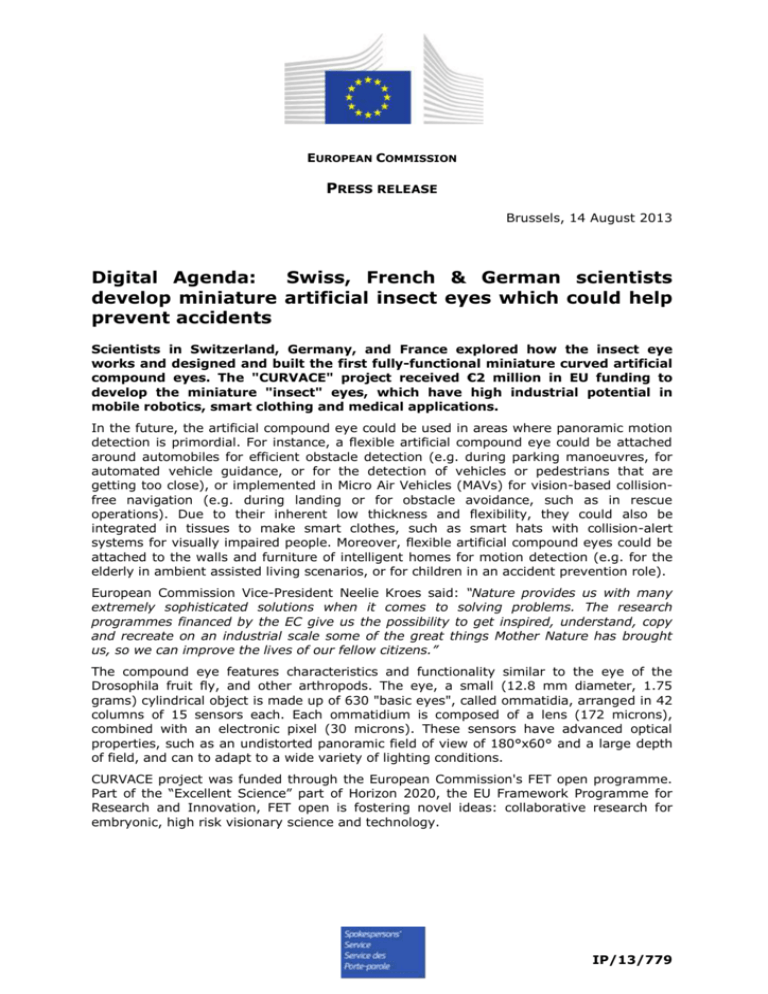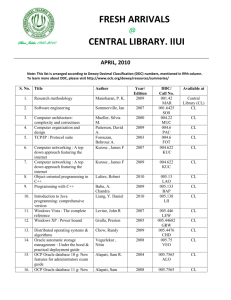DOC - Europa
advertisement

EUROPEAN COMMISSION PRESS RELEASE Brussels, 14 August 2013 Digital Agenda: Swiss, French & German scientists develop miniature artificial insect eyes which could help prevent accidents Scientists in Switzerland, Germany, and France explored how the insect eye works and designed and built the first fully-functional miniature curved artificial compound eyes. The "CURVACE" project received €2 million in EU funding to develop the miniature "insect" eyes, which have high industrial potential in mobile robotics, smart clothing and medical applications. In the future, the artificial compound eye could be used in areas where panoramic motion detection is primordial. For instance, a flexible artificial compound eye could be attached around automobiles for efficient obstacle detection (e.g. during parking manoeuvres, for automated vehicle guidance, or for the detection of vehicles or pedestrians that are getting too close), or implemented in Micro Air Vehicles (MAVs) for vision-based collisionfree navigation (e.g. during landing or for obstacle avoidance, such as in rescue operations). Due to their inherent low thickness and flexibility, they could also be integrated in tissues to make smart clothes, such as smart hats with collision-alert systems for visually impaired people. Moreover, flexible artificial compound eyes could be attached to the walls and furniture of intelligent homes for motion detection (e.g. for the elderly in ambient assisted living scenarios, or for children in an accident prevention role). European Commission Vice-President Neelie Kroes said: “Nature provides us with many extremely sophisticated solutions when it comes to solving problems. The research programmes financed by the EC give us the possibility to get inspired, understand, copy and recreate on an industrial scale some of the great things Mother Nature has brought us, so we can improve the lives of our fellow citizens.” The compound eye features characteristics and functionality similar to the eye of the Drosophila fruit fly, and other arthropods. The eye, a small (12.8 mm diameter, 1.75 grams) cylindrical object is made up of 630 "basic eyes", called ommatidia, arranged in 42 columns of 15 sensors each. Each ommatidium is composed of a lens (172 microns), combined with an electronic pixel (30 microns). These sensors have advanced optical properties, such as an undistorted panoramic field of view of 180°x60° and a large depth of field, and can to adapt to a wide variety of lighting conditions. CURVACE project was funded through the European Commission's FET open programme. Part of the “Excellent Science” part of Horizon 2020, the EU Framework Programme for Research and Innovation, FET open is fostering novel ideas: collaborative research for embryonic, high risk visionary science and technology. IP/13/779 Background The project involves 5 collaborating institutions: EPFL (Switzerland), University of AixMarseille and CNRS (France), Frauenhofer Institute for Applied Optics and Precision Engineering (Germany), and the University of Tübingen (Germany) working together for 45 months (01.10.2009 - 30.06.2013). The budget of the entire project is 2.73 million euro, with 2.09 million coming from EU financing. The results were published in the journal Proceedings of the National Academy of Sciences of the USA (PNAS). Useful links http://www.curvace.org/ http://cordis.europa.eu/projects/237940 Hashtags: @fet_eu #FP7 #FET Have your say Digital Agenda Neelie Kroes Follow Neelie on Twitter Contacts : Email: comm-kroes@ec.europa.eu Tel: +32.229.56361 Twitter: @RyanHeathEU 2








